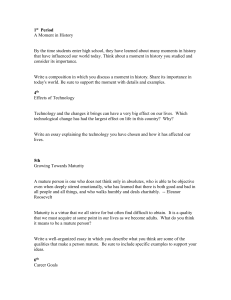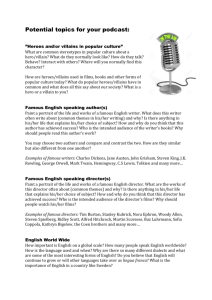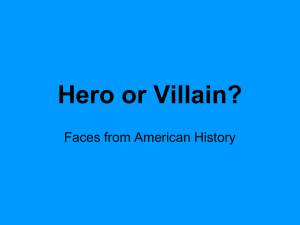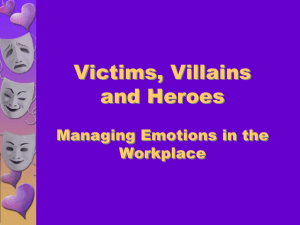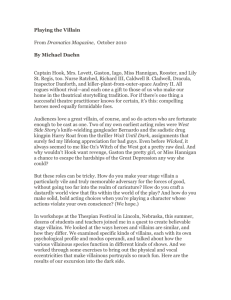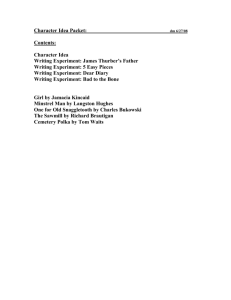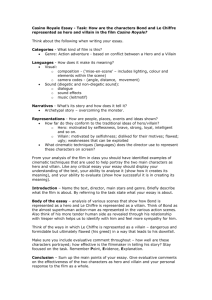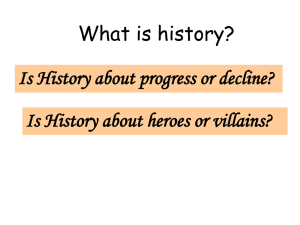Villains: (Re)presentations of the bad guy
advertisement
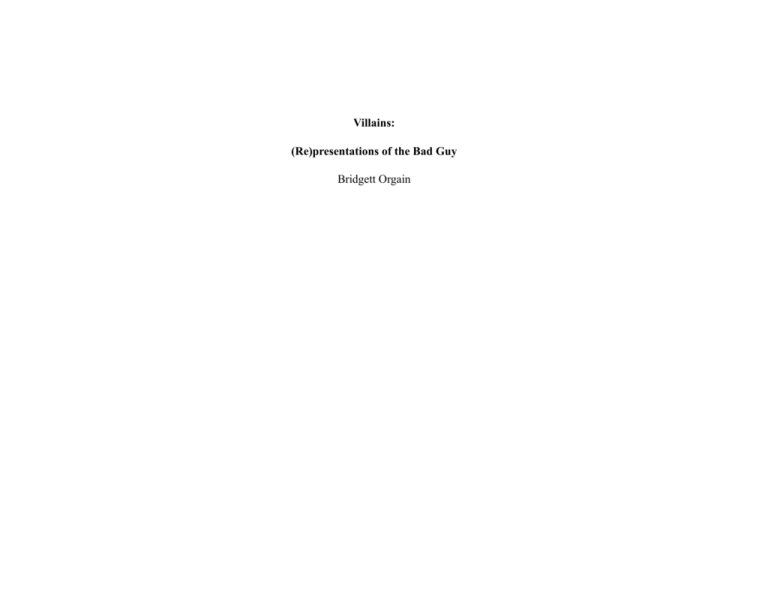
Villains: (Re)presentations of the Bad Guy Bridgett Orgain Introduction Children’s movies are filled with two key ingredients: heroes and villains. While the subject of heroes has been frequently addressed in elementary curriculum (Alvermann & Hagood 1999), the idea of villains has not been thoroughly explored or included in elementary curriculum. In the same manner that heroes help normalize what is considered good and right, representations of villains determine what is bad and wrong. Within the genre of villainy, there exist stereotypes of villains as evil, old (Robinson & Anderson 2006), and queer (Li-Vollmer & LaPointe 2003). Students need to critically engage with the genre of villains to recognize those stereotypes. In the lower elementary grades, students are also becoming a part of school culture. Already they understand the difference between good and bad behavior as defined by teachers, principles, and parents and are constructing their identity according to these hegemonic rules. A reinvestigation of villains is an opportunity for students to participate in transgressive pedagogy (Duncum 2009) and experience permutable identity (Richards 2007) – even the identity of the “bad guy”. Within the school culture, good and bad are presented as binaries. This curriculum on villains allows students to see that there are often shades of gray in-between. Villains: the good, the bad, the ugly In the simplest form, the villain is the bad guy – the antithesis to the hero. However, the stereotype of villain as evil has been played out so often that a new bad guy has come on to the scene. In the words of Wreck-It Ralph, “I'm bad, and that's good. I will never be good, and that's not bad. There's no one I'd rather be then me” (Spencer & Moore, 2012). A bad guy that isn’t a bad guy is the premise of several blockbuster films within the past few years, such as Wreck-It Ralph (Spencer & Moore, 2012), Megamind (Breay, L., Cascino, D. N., & McGrath, T., 2010), and Despicable Me (Cohen, J., Healy, J., Coffin, P., & Renaud, C., 2010). These movies suggest the villains are misunderstood instead of evil – victims of their situation that aren’t all bad. As Marriner (2011) describes, “Far from one dimensional baddies, the self-styled sinister protagonists in these films are intriguing and complex characters who look meaner than they really are” (p. 16). These misunderstood villains fall between the binaries of good and evil and are ideal examples of a moral gray. Other movies have recognized the new metanarrative of the misunderstood villain. In The Incredibles (Walker & Bird, 2004), the villain Syndrome once idolized the main character Mr. Incredible and tried to be his sidekick. When he is rejected by his idol, Buddy Pine grows up to be the evil mastermind Syndrome. This is in contrast to a long line of Disney villains that give no background history or reasoning for the villain’s evil ways. It is a realistic approach to villains, making them more human and relatable to the audience. These believable baddies are characters that children can empathize with, making meaning and connections for their own misunderstood actions. While the archetype of villain has been reinterpreted in recent media, the stereotypes perpetrated by Disney villains continue to hold strong. Classic Disney movies are an integral part of any complete childhood library of movies. A particularly disturbing stereotype that permeates the long line of Disney films is the villain-as-sissy, in which feminine qualities are vilified, particularly in men (Li-Vollmer & LaPointe, 2003). Heroes represent heteronormal behavior, which can only be defined through the understanding that villain behavior is somehow deviant or queer. Li-Vollmer and LaPoint (2003) warn “Although sexual orientation may not yet be pertinent to children’s social schemata, they may develop early negative associations with sissy traits that could feed into stereotypes of gays later in life” (p.105). The villain-as-sissy stereotype is based on physical representations, actions, and dialogue. Disney villains are portrayed in cool colors like blue and purple, often with painted eye lids. Not only is Hades from Hercules (Dewey, Tobin, Clements, & Musker, 1997) blue from head to toe, he wears a long robe that questions the gender underneath. Villains move about the scene with minimal body movements. The only big gestures are made with their finely manicured hands. Females and villains are the only characters to possess long fingernails in Disney films. They say effeminate things, such as Scar in The Lion King, “Oh, I shall practice my curtsey” (Allers, Minkoff, & Hahn, 1994). Curtsey, a feminine word, used in place of the masculine bow is a “transgressive use of language” (Li-Vollmer & LaPoint, 2003, p. 102). Everything about the representations of Disney villains is womanly and queer. Another damaging stereotype is the representation of villains as old characters. In their study on the portrayal of older characters in children’s animated television programs, Robertson and Anderson (2006) found that students entering school already held negative stereotypes about older people: When animated programs portray certain groups of people in a consistent, unvarying manner or stereotype them, children begin to believe that the images they see are acceptable and normal. Even though the largest percentage of older characters in this study were positive, there were enough negative images and characteristics that children are learning at a young age (as early as 12 months) that older characters are of little importance to the programs; that they are portrayed as angry, senile, and crazy; and that they are often the villain. (p. 298) These negative stereotypes are visible in Disney villains as well. In Disney’s first animated film Snow White and the Seven Dwarfs (Disney & Hand, 1937), the story deviates from the original Grimm fairy tale to have the Wicked Queen transform into an ugly, old witch (Nelson, 1978). It was a decision that would set the precedent for the majority of Disney villains to be drawn as old. The stigma of old age as villainous affects not only how children view older people but how they interact with them as well. Transgressive Behavior: Let’s be the bad guys. In lower Elementary grades, students have a grasp on moral reasoning and know that the “protagonist ‘should feel bad’ after a moral transgression” (Malti & Keller, 2009, p.595). These binaries of good and bad are made very clear in the school setting. Transgressive behavior from the student is actively discouraged and avoided within the classroom setting (Duncum, 2009). Logue and Detour (2011) concluded in their observations on “bad guy” play: Too often, dramatic play themes are chosen by adults to allow children to practice safe, familiar roles (e.g., community helpers, housekeeping), while the emotionally engaging themes involving the struggle between good and evil, and courage in the face of danger, are actively discouraged, especially when the play script involves bad guys. (p. 14) When they allowed transgressive “bad guy” play to occur naturally, they observed children developed complex play interactions, including “high levels of cooperation, consideration, impulse control, memory, and planning” as well as “levels of sustained attention, planful negotiation, cooperation, and inclusive play among the children” (Logue & Detour, 2011, p. 14). Allowing transgressive behavior through a villainous permutable identity is important because it “enables students to explore the many facets of their personality, to act out roles, and to toy with social prohibitions, without risking consequences such as exclusion” (Richards, 2007, p. 27). The identity of bad guy is one they will toy with on their own. Pushing buttons and limits is a natural childhood behavior to learn boundaries. However, this behavior carries unwanted consequences for the child that could be avoided through a pedagogy that allows transgressions as part of learning. In Alvermann & Hagood’s (1999) curriculum on Superheroes, students constructed the ideal superhero from parts of existing superheroes. This led to critical reflection and growth on the part of some students, specifically the student Chris who was able to express fears about death (p. 49-50). Visual narratives based on villains have the same potential for personal critical reflection by challenging the binaries of good and evil. While it is easier to label and define all things, people, and actions as either good or bad, the reality is not so black and white. By allowing students to take on the role of the bad guy, the pleasure of transgression is acknowledged (Duncum, 2009) and the opportunity for students to reflect on their decision making as well as the decision making of others is presented. Conclusion Throughout this unit, students will reflect on popular culture texts that utilize the archetype of villain, negative stereotypes, and ideas of good vs. evil. Furthermore, they will explore permutable identity by participating in visual narrative activities that reinvestigate the villain, including taking on the role of villain themselves. In preparation for their final visual narrative, they will learn about character design and the use of storyboards to develop a story. Their final project will be to construct a full visual narrative around a new villain that (re)presents what it means to be the bad guy using their design and conceptualizing skills. The goal for students while they are exploring representations of villains is to recognize associated stigma and acknowledge normalized behavior through the villainous other. In a time where children are trying on new identities as often as they grow out of shoes, it is important to allow them to take on the role of villain and challenge binary ideas of good and bad. It is through challenging ideas that personal growth and understanding can happen. References Allers, R., (Producer) Minkoff, R., (Producer) & Hahn, D. (Director). (1994). The Lion King [Motion picture]. United States: Walt Disney Pictures. Alvermann, D. E., Moon, J. S., & Hagood, M. C. (1999). Popular culture in the classroom: Teaching and researching critical media literacy. Newark, DE: International Reading Association. (pp 22-40). Breay, L., (Producer) Cascino, D. N. (Producer), & McGrath, T. (Director). (2010). Megamind [Motion picture]. United States: DreamWorks Animation. Cohen, J., (Producer) Healy, J. (Producer), Coffin, P., (Director) & Renaud, C. (Director). (2010). Despicable Me [Motion picture]. United States: Universal Pictures. Dewey, A. (Producer), Tobin, N. (Producer), Clements, R. (Director), & Musker, J. (Director). (1997). Hercules [Motion picture]. United States: Walt Disney Pictures. Disney, W. (Producer) & Hand, D. (Director). (1937). Snow White and the Seven Dwarfs [Motion picture]. United States: Walt Disney Productions. Duncum, P. (2009). Toward a playful pedagogy: Popular culture and the pleasures of transgression. Studies in Art Education, 50(3), 232-244. Li-Vollmer, M., & LaPointe, M. E. (2003). Gender transgression and villainy in animated film. Popular Communication, 1(2), 89. Logue, M., & Detour, A. (2011). "You be the bad guy": A new role for teachers in supporting children's dramatic play. Early Childhood Research & Practice, 13(1). Malti, T., & Keller, M. (2009). The relation of elementary-school children's externalizing behaviour to emotion attributions, evaluation of consequences, and moral reasoning. European Journal Of Developmental Psychology, 6(5), 592-614. Marriner, K. (2011). Not so evil after all. Screen Education, (61), 16-25. Richards, M. (2007). Engaging “looking-glass” youth in art through the visual narratives of the transforming self in popular culture. Visual Arts Researh, 33(65), 24-37. Robinson, T., & Anderson, C. (2006). Older Characters in Children's Animated Television Programs: A Content Analysis of Their Portrayal. Journal Of Broadcasting & Electronic Media, 50(2), 287-304. Spencer, C. (Producer), & Moore, R. (Director). (2012). Wreck-It Ralph [Motion picture]. United States: Walt Disney Animation Studios. Walker, J. (Producer) & Bird, B. (Director). (2004). The Incredibles [Motion Picture]. United States: Walt Disney Pictures. Curriculum Unit Theme: Villains Teacher: Bridgett M. Orgain Grade Level: K-3 State Visual Art Goals: VAK-1.1, VAK-1.3, VAK-3.1, VAK-3.2, VAK-6.2, VA1-1.1, VA1-1.3, VA1-1.4, VA1-3.1, VA1-3.2, VA1-3.3, VA1-6.2, VA2-1.1, VA2-1.3, VA2-1.4, VA2-3.1, VA2-3.2, VA2-3.3, VA2-6.2, VA3-1.1, VA3-1.3, VA3-1.5, VA3-2.4, VA3-3.1, VA3-3.2, VA3-3.3, VA3-6.2 State Media Arts Goals (if any): MAK-3.3, MA1-3.3, MA2-3.3, MA3-3.3 State Language Arts Goals (if any): K-4.1, K-4.2, K-4.3, K-5.2, 1-4.1, 1-4.3, 1-5.2, 1-6.5, 2-4.1, 2-4.2, 2-5.2, 2-6.5, 2-6.6, 3-4.1, 3-4.2, 3-5.2, 3-6.6 General goals for the curriculum (describe in 2-5 sentences): • • • By teaching this unit, I would like for my students to critically engage with popular culture texts that utilize the archetype of “villain”. Through a reinvestigation of “villain”, they will explore stereotypes, ideas of “good vs. evil,” and permutable identity. Students will learn about the design process of creating characters and stories Students will use a the media of their choice (pencils, crayons, color pencils, paint, glue, pastels, etc) to create their own characters and visual narratives Lesson Visual Exemplars Title (list specific images and (name each artists, TV shows, and/or lesson to reflect books that you plan to use for a general unit each lesson) theme) Lesson 1 What is a villain? (one class) Motivation / Dialogue (list basic issues and questions to be explored during classroom dialogue and any other motivational strategies that you plan to use for each lesson) Media / Process Concepts and/or (list artistic processes that Design Principles to be your students will engage learned during each in during each lesson) lesson None. This is to avoid a list A. Issues -Students will verbally of characteristics that -Definition of villain create a list of describes the examples. -Stereotypes of villains characteristics to Characteristics should B. Discussion Questions describe villains to describe the genre of -What is a villain? write on the board villains and not any specific -What do villains look like? -Student will choose 3 villain. -Are there more female or male characteristics to make a drawing from villains? -Students will draw a -Are villains evil? -What makes someone become villain using the descriptive words they a villain? chose -Are villains just in stories? -What are characteristics of a Materials villain? -9”x11” paper -How are villains different than -Pencils, crayons, heroes? markers, color pencils Closure/ Assessment (list an assessment strategy used for each lesson) -Students will begin to -Were the understand that students able to character traits can be describe represented through characteristics of drawing villains? -Students will -Did the student understand that villains draw a villain? are drawn with a -Did the student specific set of incorporate the 3 characteristics (i.e. characteristics sneaky, evil, unhappy, they chose or did old, scary) they draw an existing villain? Vocabulary -Villain -Hero -Evil -Good Lesson 2 Comparing Villains to Heroes (one class) A. Comparisons of Disney A. Issues villains to their heroes -Representations of Villains -Governor Ratcliffe vs. and Heroes John Smith (Pocahontas) -Stereotypes of Villains as -Hades vs. Hercules “sissy” (Hercules) B. Discussion Questions -Jafar vs. Aladdin (Aladdin) -How can you tell who is the villain and who is the hero? -Why do the villains wear long robes instead of pants? -Do the heroes wear makeup? -Do the villains? What colors do the villains wear? The heroes? -Are villains as masculine as heroes? -Is this a stereotype? -Students will verbally -Students will describe the differences understand that the in visual portrayal of villains as representations of less masculine than Disney heroes and heroes is a stereotype villains -Students will draw a Vocabulary villain that breaks out -Stereotype of the stereotype of “sissy” Materials -9”x11” paper -Pencils, crayons, markers, color pencils -Was the student able to verbally identify the visual differences between the representations of villains and heroes? -Was the student able to draw a villain that broke the stereotype of sissy villain? Lesson 3 Not so evil anymore (one class) A. Trailer for Despicable Me B. Clip from Megamind (the scene from Megamind’s childhood growing up in prison) A. Issues -Students will -Villains as misunderstood (re)present an existing instead of evil villain as -Breaking stereotype of good misunderstood instead vs. evil of just evil B. Discussion Questions -How did they become Materials villains? -9”x11” paper -Are Gru and Megamind bad -Pencils, crayons, guys? markers, color pencils -Do they deserve to be called villains? -If Megamind hadn’t grown up in a prison, would he still be a villain? -Is Megamind insecure? -Are they evil or just misunderstood? -What other villains are just misunderstood? -Students will learn about the character type “antihero” -Students will draw a visual narrative about how their favorite “evil” villain is just misunderstood Vocabulary -Supervillain -Antihero -Was the student able to pick their favorite villain? -Was the student able to (re)present that villain as misunderstood and not wholly evil? -Was the student able to narrate this story through visual and/or verbal means? Lesson 4 A. Female Villains A. Issues -Students will describe -Students will Villains as old -Ursula (The Little -Representations of villains as common characteristics recognize the (one class) Mermaid) old and ugly of example villains stereotype of villains -The Queen/Hag (Snow -Representations of female -Students will pick an as old White) villains as witches and hags old villain and draw -Maleficent (Sleeping B. Discussion Questions their younger versions Beauty) -What do these villains have in B. Male Villains common? Materials -Jafar (Aladdin) -Are female villains concerned -9”x11” paper -Hades (Hercules) with beauty? -Pencils, crayons, -Governor Ratcliffe -Are male villains concerned markers, color pencils (Pocahontas) with beauty? -Judge Frollo (The -How would you describe old Hunchback of Notre Dame) people? -Were these characters villains when they were younger? Why do you think they became villains? In what ways are the younger versions of these villains different? -Was the student able to identify the commonalities among the examples? -Was the student able to reimagine a villain as young? -Was the student able to describe how the younger villain was different, either verbally or written? Lesson 5 Why be a villain? (one class) n/a A. Issues -Transgressive behavior as a part of us all -Why we bully B. Discussion Questions -Are there villains in real life? -Have you ever been the bad guy? -Have you ever been bullied? -Have you ever done something that you knew was wrong, but thought was fun? -If you could do something “bad” and not get caught, what would you do? -When has someone been bad to you? -Have you ever been bullied? -Have you ever bullied someone else? -Why do you think they were bad? -Did they look like a villain or did you know they were a villain from their action? -Students will draw a -Students will reflect -Was the student visual narrative in on why they have been able to think of an which either they were “bad” in their own life example when the bad guy or someone -Students will reflect they have been was bad to them on the “bad guys” in bad? -Students will describe their life, perhaps a -Was the student the motivations for bully or sibling able to assume the being bad role of the “bad Vocabulary guy” through Materials -Bullying dialogue or visual -9”x11” paper narrative? -Pencils, crayons, -Did the student’s markers, color pencils visual narrative show an understanding of motivations for being bad? Lesson 6 DIY Villain (one class) n/a A. Issues -Students will draw -Students will use a -Creating their own villain their own villain variety of drawing B. Discussion Questions -Students will draw media (pencil, crayon, -Do you want to be a villain? their villain’s family, color pencil) to -What physical traits will let us hide out/secret lair, side illustrate their villain know that your character is a kick/minions, arch -Students will think villain? enemy about each visual -Are actions more important to aspect of their villain, being a villain than Materials from head to toe appearance? -9”x11” paper -Students will reflect -Does your villain have a -Pencils, crayons, on their use of secret lair? Family? Minions? markers, color pencils stereotypes to convey Arch enemy? characteristics of -What is your villain’s story? villains -Why are they a villain? Lesson 7 Character Design (one class) A. The Little Mermaid special edition DVD -concept artwork in extras -different versions of Ursula A. Issues -Character Design B. Discussion Questions -Why do artists draw multiple versions of a character? -Is the final design of Ursula the best? -What clothes will your villain wear? -What colors will you use? -Students will draw 3 versions of either their own villain (see DIY Villain) or an existing villain -Was the student able to draw an original villain and not copy an existing villain? -Students will -Was the student understand the able to draw 3 character design versions of the process same villain? -Students will reflect -Was the student on how changes in the able to identify Materials physical representation stereotypes they -9”x11” paper of their villain can used (age, -Pencils, crayons, change the personality gender, etc)? markers, color pencils of their villain Vocabulary -Character Design -Concept Artwork Lesson 8 A. Storyboard drawings Storyboarding from Aladdin (one class) B. Storyboard drawings from 101 Dalmatians C. Kingdom Hearts manga (graphic novel) A. Issues -Visual Narratives -Storyboards -Comics/Manga/Graphic Novels B. Discussion Questions -How do artists tell a story without words? -Are storyboards and comic books more effective than words? -Students will draw 3 or -Students will more thumbnail scenes understand the use of using their villain storyboards to show a -Students will arrange scene progression and rearrange their -Students will scenes into storyboards understand importance and graphic novel of placement progressions Vocabulary Materials -Storyboard -5”x6” paper -Comic book -Pencils, crayons, -Manga markers, color pencils -Graphic novel -Was the student able to draw 3 or more consecutive frames? -Was the student able to arrange those scenes in a progression that made sense? Lesson 9 Creating the Story (three classes) A. Previous drawings -Each student will examine their own body of work to pick a villain to expand upon B. Cover artwork -Wreck It Ralph movie poster -Despicable Me logo A. Issues -Students will draw 8 or -Students will -Telling a Visual Narrative more 5”x6” frames to construct their final -Cover artwork illustrate their villain’s visual narrative B. Discussion Question story -Students will rely on -How will you choose which -Students will fully the knowledge they villain to create a full story for? illustrate each frame learned on character -How do movie posters and with color design and books covers convey who the -Students may include storyboarding main character is? text -Do you get a sense of Ralph’s -Students will paste Vocabulary personality from the movie each frame into a blank -Cover Art poster? book in a logical -How do you know that progression Despicable Me is a movie -Students will draw about a villain from just the their story cover movie logo? -Students will paint the final version of their story cover on a blank book Materials -blank book -5”x6” paper -Pencils, crayons, markers, color pencils, paint -Was the student able to flesh out a villain and story? -Was the student able to design a cover for their book? -Was the student able to draw all the frames of their story? -Was the student able to put the frames in their book in a logical progression? Lesson 10 Sharing Our Stories (one class) n/a A. Issues -Reflection B. Discussion Questions -Read and/or describe your story -What does your villain look like? -Is your villain evil or an antihero? -Did you use any stereotypes? -Is there anything you would change? -Students will share their stories by either reading the text they incorporated and/or describing the scenes they illustrated -Students will reflect -Was the student on the choices they about to create a made in character complete design and story narrative? -Students will answer -Was the student questions about their able to recognize villain and story to stereotypes? further reflect on visual -Was the student choices able to identify their choices in their villain’s appearance and story? Lesson #3 Title: Not So Evil Anymore Grade: K-3 Teacher: Bridgett M. Orgain Length: One class period (45 minutes) State visual art goals: VAK-1.1, VAK-1.3, VAK-3.1, VAK-3.2, VAK-6.2, VA1-1.1, VA1-1.3, VA1-1.4, VA1-3.1, VA1-3.2, VA1-3.3, VA1-6.2, VA2-1.1, VA2-1.3, VA2-1.4, VA2-3.1, VA2-3.2, VA2-3.3, VA2-6.2, VA3-1.1, VA3-1.3, VA3-1.5, VA3-2.4, VA3-3.1, VA3-3.2, VA3-3.3, VA3-6.2 State media arts goals (if any): n/a State language arts goals (if any): K-4.1, K-4.2, K-4.3, K-5.2, 1-4.1, 1-4.3, 1-5.2, 1-6.5 Objectives: • Students critically engage with popular culture texts that utilize the archetype of “villain”. • Students will challenge binaries of “good vs. evil • Students will learn about the character type “antihero” • Students will draw a visual narrative about how their favorite “evil” villain is just misunderstood Concepts and vocabulary: • Supervillain - A fantasy fiction criminal or evil-doer, often with supernatural powers or equipment, in popular children's and fantasy literature who can present a credible challenge for a superhero • Antihero - A central character in a story, movie, or drama who lacks conventional heroic attributes, such as idealism and courage Teacher materials: • Trailer for Despicable Me • Clip from Megamind (the scene from Megamind’s childhood growing up in prison) Student materials: • 9”x11” paper • Pencils, crayons, markers, color pencils Procedures (detailed step-by-step description including dialogue): Introduction (10 minutes) • After students have entered and are seated, the class will watch the trailer for Despicable Me. • Through teacher guided discourse, the class will describe the plot and characters of the movie. • The class will watch a clip from Megamind that shows his childhood growing up in a prison. • Through teacher guided discourse, the class will describe the plot and characters of the movie, with a focus on Megamind’s childhood. • Students will learn what a supervillain is. • Student will learn what an antihero is. Discussion (10 minutes) Students will answer questions to challenge the stereotype of villains as evil. • How did they become villains? • Are Gru and Megamind bad guys? • How are Gru and Megamind similar? Different? • Do they deserve to be called villains? • If Megamind hadn’t grown up in a prison, would he still be a villain? • Is Megamind insecure? • Are they evil or just misunderstood? • What other villains are just misunderstood? Activity (15 minutes) • After the discussion, students will choose a villain to (re)present as misunderstood instead of evil. Their choice cannot be an existing antihero villain, such as Wreck-It Ralph • Students will be given paper and a selection of drawing tools to draw their selected villain in a visual narrative that explains the motivations for their bad guy ways • Students may include text if they are so inclined, but it is not a requirement of this activity Closure (10 minutes) • Students will share their drawing with the teacher and give a brief verbal explanation of their representation Assessment/Closure: • • • Was the student able to pick their favorite villain? Was the student able to (re)present that villain as misunderstood and not wholly evil? Was the student able to narrate this story through visual and/or verbal means? Learning center/ back up activity (if any): •If the student does not have a favorite villain, they can invent their own villain with a back story for that villain. •If the student cannot imagine their own villain, they can draw Gru or Megamind as children and narrate other struggles their antiheros faced.
